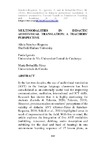Multimodalities in didactic audiovisual translation : a teachers' perspective

Use this link to cite
http://hdl.handle.net/2183/35613Collections
- Investigación (FEDU) [939]
Metadata
Show full item recordTitle
Multimodalities in didactic audiovisual translation : a teachers' perspectiveDate
2022Citation
Sánchez-Requena, A.; Igareda, P.; Bobadilla-Pérez, M. (2022). Multimodalities in didactic audiovisual translation: A teachers’ perspective. Current Trends in Translation Teaching and Learning E, 9, 337–372. https://doi.org/10.51287/ctt l202210
Abstract
[Abstract] In the last two decades, the use of audiovisual translation (AVT) in the foreign language classroom has been consolidated as an extremely useful tool for improving communication, mediation, intercultural and ICT skills. Research has shown that it is highly motivating for students (Lertola & Talaván, 2020; Talaván, 2019). However, previous studies on teachers’ perceptions of the validity of didactic AVT (Alonso-Pérez & Sánchez-Requena, 2018; Sokoli et al., 2011) highlighted areas in need of improvement in the field. With this in mind, the article explores the integration of five AVT modalities (subtitling, voiceover, dubbing, audio description and subtitling for the deaf and hard of hearing) in one autonomous learning sequence of 15 lesson plans, as designed by members of the research project TRADILEX, funded by the Spanish Ministry of Science, Innovation and Universities. This paper analyses the results of a questionnaire completed by teachers (N=30) who supervised the implementation of this learning sequence in B1 and B2 proficiency level courses from higher education language centres. The main aim of this article is to determine to what extent this new approach addresses the weaknesses observed by teachers in previous studies. The analysis of the gathered data led to conclude that teacher training in didactic AVT significantly improves the implementation of the methodology. Besides that, the comprehensive approach of the TRADILEX sequence, including the five AVT modalities, allowed teachers to identity which modality is better suited for their teaching practice. On the other hand, high dependence on technology and motivation were two of the main concerns shown by teachers which require further research.
Keywords
Didactic audiovisual translation
Foreign language education
Teachers’ perspectives
TRADILEX project
Foreign language education
Teachers’ perspectives
TRADILEX project
Editor version
Rights
Atribución-NoComercial 3.0 España
ISSN
2342-7205






